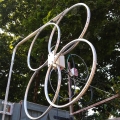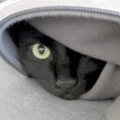G8JNJ
About
- Username
- G8JNJ
- Joined
- Visits
- 3,352
- Last Active
- Roles
- Member
- Points
- 400
Reactions
-
Problem with audio - Chrome [fixed, Windows 10 settings issue]
The issue was not associated with just the KiWi or cookies and I subsequently found that it affected other websites with audio enabled too.
After a lot of messing around I discovered that the problem was associated with the settings in Windows 10 App volume and device preferences.
Google had somehow got a different soundcard defined as the default, but for some reason the first browser session to be opened used the default device and any subsequent sessions opened the device defined for that application.
Reverting all back to the default fixed the problem (until the next time).
There are many different ways of defining the soundcard to be used in Win 10 and associated applications, so I'm not surprised they occasionally get out of sync with each other.
I'm not sure what caused it on this occasion, although it could have been associated with connecting a USB headset I occasionally use for Skype.
Regards,
Martin - G8JNJ -
Problem with audio - Chrome [fixed, Windows 10 settings issue]
The issue was not associated with just the KiWi or cookies and I subsequently found that it affected other websites with audio enabled too.
After a lot of messing around I discovered that the problem was associated with the settings in Windows 10 App volume and device preferences.
Google had somehow got a different soundcard defined as the default, but for some reason the first browser session to be opened used the default device and any subsequent sessions opened the device defined for that application.
Reverting all back to the default fixed the problem (until the next time).
There are many different ways of defining the soundcard to be used in Win 10 and associated applications, so I'm not surprised they occasionally get out of sync with each other.
I'm not sure what caused it on this occasion, although it could have been associated with connecting a USB headset I occasionally use for Skype.
Regards,
Martin - G8JNJ -
Electric fence noise
Modern electric fence energisers have 'pulse shaping' which minimises noise from the energiser itself, so most problems are associated with arcing or insulation breakdown.
One quick test is to disconnect the energiser and measure the resistance between the ground spike and the fence. This will usually indicate if there is any general degradation of the insulation to ground due to muck or moisture on the insulators. However it will not show up voltage breakdown or arcing when the normal high voltage pulses are applied, but you can often hear this acoustically (or sometimes see it) if you walk the length of the fence.
The ARRL have some notes but other references can be found on-line.
https://www.arrl.org/files/file/Technology/Electric_Fence/Electric_Fence_Procedure.pdf
http://www.arrl.org/files/file/Technology/tis/info/pdf/9604062.pdf
Regards,
Martin - G8JNJ -
Electric fence noise
Modern electric fence energisers have 'pulse shaping' which minimises noise from the energiser itself, so most problems are associated with arcing or insulation breakdown.
One quick test is to disconnect the energiser and measure the resistance between the ground spike and the fence. This will usually indicate if there is any general degradation of the insulation to ground due to muck or moisture on the insulators. However it will not show up voltage breakdown or arcing when the normal high voltage pulses are applied, but you can often hear this acoustically (or sometimes see it) if you walk the length of the fence.
The ARRL have some notes but other references can be found on-line.
https://www.arrl.org/files/file/Technology/Electric_Fence/Electric_Fence_Procedure.pdf
http://www.arrl.org/files/file/Technology/tis/info/pdf/9604062.pdf
Regards,
Martin - G8JNJ -
v1.360+: DRM extension now available
Hi John & All Happy New Year to everyone.
Even if it's not possible to decode DRM because the KiWI is occupied, could it be made so that you can still open up the DRM schedule screen so that you can select and tune to stations to see if they are transmitting DRM, even if it's not possible to decode it at the time ?
Also if the DRM extension is selected but the KiWi is occupied, could the DRM extension wait and reserve a slot, but start working when the KiWi has become clear for use ?
Regards,
Martin - G8JNJ -
Multiple "Sweepers" on my Cascade
It's Over The Horizon Radar (OTHR)
https://en.wikipedia.org/wiki/Over-the-horizon_radar
There are Six 'usual suspects'
These four tend to sit on specific frequencies for long periods of time.
Cyprus (Pluto)
China
Russia (Kontayner)
Iran (Ghadir)
What you are seeing is probably either Jindalee Operational Radar Network (JORN) from Australia or Superdarn
These move around to track propagation, but tends to operate on frequencies close to each other.
JORN also tends to change the sweep rate on a specific frequency, typically switching between three different rates in sequence.
https://en.wikipedia.org/wiki/Jindalee_Operational_Radar_Network
https://www.sigidwiki.com/wiki/Jindalee_Operational_Radar_Network_(JORN)
https://en.wikipedia.org/wiki/Super_Dual_Auroral_Radar_Network
https://www.sigidwiki.com/wiki/SuperDARN_(Super_Dual_Auroral_Radar_Network)
https://superdarn.ca/real-time
https://www.sigidwiki.com/wiki/PLUTO_II_OTH_Radar
http://www.chinatopix.com/articles/112419/20170314/radar-thaad-over-the-horizon-radar-oth-radar-intercontinental-ballistic-missile.htm
https://en.wikipedia.org/wiki/Container_radar
https://www.sigidwiki.com/wiki/29B6_'Kontayner'_OTH_Radar
https://www.sigidwiki.com/wiki/'Ghadir'_OTH_Radar
In addition there are many surface wave radars, but these tend to be a lot weaker and have a slower sweep rate.
http://www.codar.com/intro_hf_radar.shtml
https://cordc.ucsd.edu/projects/mapping/maps/
https://www.sigidwiki.com/wiki/CODAR
Regards,
Martin - G8JNJ -
Questions About the Mini-Whip Antenna
Just a couple of additional thoughts following on from Stu's post.
Both techniques of screening and choking are important, but they perform different functions and have to be applied appropriately.
"Quad shielded" coax can be many things, but these days many of them are just marketing hype.
In the past coaxes with multiple screens that were insulated from each other were used for video distribution in TV studios, where it was necessary to separate 'clean' and 'dirty' electrical grounds from each other, so that very low level noise didn't get introduced into the analogue DC to <10MHz video circuits.
Quad shielded coax as referred to these days, tends to be a generic term that means it incorporates other cores around the inner, and some of these may simply be to provide additional mechanical strength or protection, such as steel reinforcing strands.
It's best to avoid coaxes that have a plated steel cored center conductor and also those with aluminium foil screen or aluminium conductors.
All of these can cause problems on the lower frequencies where the conductor skin depth is not adequate for the purpose on the LF bands.
Common mode noise is carried on the outside of the coax screen, and so as long as the skin depth of the conductor is sufficient, it will remain there and any additional screening won't make much of a difference.
The problem arises at the ends of the coax where it is terminated, and makes a transition from balanced to unbalanced due to the current on the outside of the outer screen.
Common mode chokes are required to reduce the amount of common mode current that can be carried along the outer of the screen and can be re-radiated to be received by the antenna. It can also be directly re-introduced into the balanced signal path of the coax by incorrect termination of the screen at that transition point.
The frustrating thing about common mode chokes is that it's a bit like playing 'Whack a Mole' as soon as you put a choke in one place, the current distribution changes and the noise can pop up on a different frequency. Some degree of experimentation is required to find the best placement, and this often changes when you connect new items of equipment, or even in some cases when you simply plug another item of electrical equipment such as an extension lead, and the long mains cable modifies the RF current distribution on various surrounding structures.
I have used an E-Probe mounted above the metal roof of an industrial building full of various items of consumer electronics and server farms. The trick is to use the metal roof (and frame of the building) as the ground plane for the antenna, but to ensure that the coax has lots of common mode chokes fitted on the 'building side' of the ground plane connection, so that noise from within the building is not introduced onto the antenna itself.
Regards,
Martin - G8JNJ -
Multiple "Sweepers" on my Cascade
It's Over The Horizon Radar (OTHR)
https://en.wikipedia.org/wiki/Over-the-horizon_radar
There are Six 'usual suspects'
These four tend to sit on specific frequencies for long periods of time.
Cyprus (Pluto)
China
Russia (Kontayner)
Iran (Ghadir)
What you are seeing is probably either Jindalee Operational Radar Network (JORN) from Australia or Superdarn
These move around to track propagation, but tends to operate on frequencies close to each other.
JORN also tends to change the sweep rate on a specific frequency, typically switching between three different rates in sequence.
https://en.wikipedia.org/wiki/Jindalee_Operational_Radar_Network
https://www.sigidwiki.com/wiki/Jindalee_Operational_Radar_Network_(JORN)
https://en.wikipedia.org/wiki/Super_Dual_Auroral_Radar_Network
https://www.sigidwiki.com/wiki/SuperDARN_(Super_Dual_Auroral_Radar_Network)
https://superdarn.ca/real-time
https://www.sigidwiki.com/wiki/PLUTO_II_OTH_Radar
http://www.chinatopix.com/articles/112419/20170314/radar-thaad-over-the-horizon-radar-oth-radar-intercontinental-ballistic-missile.htm
https://en.wikipedia.org/wiki/Container_radar
https://www.sigidwiki.com/wiki/29B6_'Kontayner'_OTH_Radar
https://www.sigidwiki.com/wiki/'Ghadir'_OTH_Radar
In addition there are many surface wave radars, but these tend to be a lot weaker and have a slower sweep rate.
http://www.codar.com/intro_hf_radar.shtml
https://cordc.ucsd.edu/projects/mapping/maps/
https://www.sigidwiki.com/wiki/CODAR
Regards,
Martin - G8JNJ -
Multiple "Sweepers" on my Cascade
It's Over The Horizon Radar (OTHR)
https://en.wikipedia.org/wiki/Over-the-horizon_radar
There are Six 'usual suspects'
These four tend to sit on specific frequencies for long periods of time.
Cyprus (Pluto)
China
Russia (Kontayner)
Iran (Ghadir)
What you are seeing is probably either Jindalee Operational Radar Network (JORN) from Australia or Superdarn
These move around to track propagation, but tends to operate on frequencies close to each other.
JORN also tends to change the sweep rate on a specific frequency, typically switching between three different rates in sequence.
https://en.wikipedia.org/wiki/Jindalee_Operational_Radar_Network
https://www.sigidwiki.com/wiki/Jindalee_Operational_Radar_Network_(JORN)
https://en.wikipedia.org/wiki/Super_Dual_Auroral_Radar_Network
https://www.sigidwiki.com/wiki/SuperDARN_(Super_Dual_Auroral_Radar_Network)
https://superdarn.ca/real-time
https://www.sigidwiki.com/wiki/PLUTO_II_OTH_Radar
http://www.chinatopix.com/articles/112419/20170314/radar-thaad-over-the-horizon-radar-oth-radar-intercontinental-ballistic-missile.htm
https://en.wikipedia.org/wiki/Container_radar
https://www.sigidwiki.com/wiki/29B6_'Kontayner'_OTH_Radar
https://www.sigidwiki.com/wiki/'Ghadir'_OTH_Radar
In addition there are many surface wave radars, but these tend to be a lot weaker and have a slower sweep rate.
http://www.codar.com/intro_hf_radar.shtml
https://cordc.ucsd.edu/projects/mapping/maps/
https://www.sigidwiki.com/wiki/CODAR
Regards,
Martin - G8JNJ -
Multiple "Sweepers" on my Cascade
It's Over The Horizon Radar (OTHR)
https://en.wikipedia.org/wiki/Over-the-horizon_radar
There are Six 'usual suspects'
These four tend to sit on specific frequencies for long periods of time.
Cyprus (Pluto)
China
Russia (Kontayner)
Iran (Ghadir)
What you are seeing is probably either Jindalee Operational Radar Network (JORN) from Australia or Superdarn
These move around to track propagation, but tends to operate on frequencies close to each other.
JORN also tends to change the sweep rate on a specific frequency, typically switching between three different rates in sequence.
https://en.wikipedia.org/wiki/Jindalee_Operational_Radar_Network
https://www.sigidwiki.com/wiki/Jindalee_Operational_Radar_Network_(JORN)
https://en.wikipedia.org/wiki/Super_Dual_Auroral_Radar_Network
https://www.sigidwiki.com/wiki/SuperDARN_(Super_Dual_Auroral_Radar_Network)
https://superdarn.ca/real-time
https://www.sigidwiki.com/wiki/PLUTO_II_OTH_Radar
http://www.chinatopix.com/articles/112419/20170314/radar-thaad-over-the-horizon-radar-oth-radar-intercontinental-ballistic-missile.htm
https://en.wikipedia.org/wiki/Container_radar
https://www.sigidwiki.com/wiki/29B6_'Kontayner'_OTH_Radar
https://www.sigidwiki.com/wiki/'Ghadir'_OTH_Radar
In addition there are many surface wave radars, but these tend to be a lot weaker and have a slower sweep rate.
http://www.codar.com/intro_hf_radar.shtml
https://cordc.ucsd.edu/projects/mapping/maps/
https://www.sigidwiki.com/wiki/CODAR
Regards,
Martin - G8JNJ


